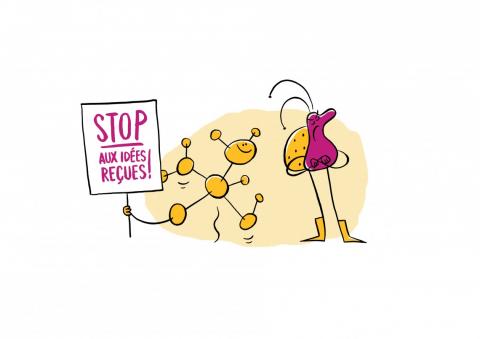NO to popular misconceptions in chemistry! (2/3)
At a time when climate, the environment and the protection of our planet are finally taking centre stage, Université Paris-Saclay...

At a time when climate, the environment and the protection of our planet are finally taking centre stage, Université Paris-Saclay, which has a large community of chemists with its researchers and students, has chosen to focus on chemistry. This exciting discipline, which studies the composition, properties and transformations of matter, suffers from a negative public image. The time has come to correct the stereotypes that overshadow the variety and wealth of the fields of chemistry, covered by research, training and professions. It is also time to shed light on the way chemistry contributes to major societal issues. "NO to popular misconceptions in chemistry!": a series of deliberately quirky illustrations that we hope will spark a debate! (Episode 1/3)
If the idea is understandable, chemistry is behind the very act of eating! When we eat, we ingest hundreds of thousands of molecules of amino acids, carbohydrates, proteins, lipids, minerals, vitamins and trace elements. These different nutrients are then collected by the body, reorganised and reassembled so they can be used as an energy source – sugars - or build the human body – lipids for cell membranes and amino acids for protein synthesis.
On a daily basis, and often without knowing it, everyone does chemistry, thanks to... the kitchen! This ancestral activity is a succession of chemical reactions: we find the reagents (food), the actors of the chemical reaction (temperature, pressure and quantities), and the products of the reaction. For example, to make caramel, table sugar (sucrose) is heated to a certain temperature, with or without water depending on the recipe. In both cases, this results in the degradation of sucrose molecules into two types of molecules, fructose and glucose, which rearrange into long chains of molecules, oligosaccharides, which constitute caramel.
In chemistry, the quality of a substance is defined essentially through the properties that give it its structure – the sequence of atoms and how each is arranged in relation to the others – and is in no way linked to the origin, whether natural or synthetic, of the molecule. For instance, the vanillin molecule found in the pods of the vanilla plant gives vanilla its characteristic flavour. As global demand for the flavour is impossible to satisfy through the production of pods from vanilla plants alone, vanillin is also synthesised in laboratories. Ultimately, both molecules have the same flavour, because their atoms are arranged in the same way.
(Drawings by Elena Vieillard)
At a time when climate, the environment and the protection of our planet are finally taking centre stage, Université Paris-Saclay...
At a time when climate, the environment and the protection of our planet are finally taking centre stage, Université Paris-Saclay...